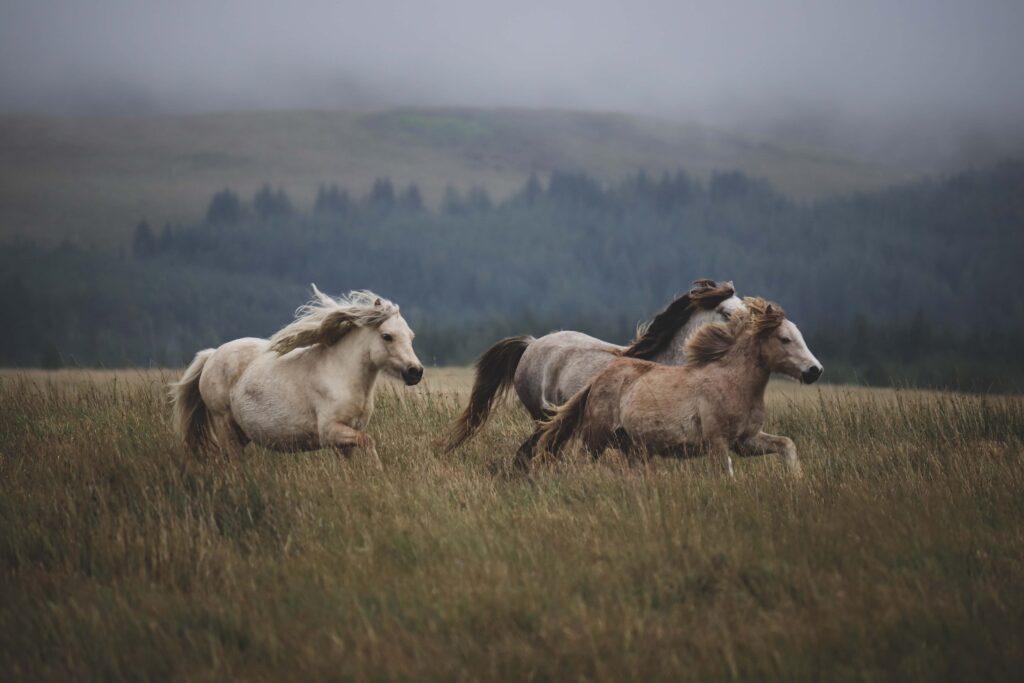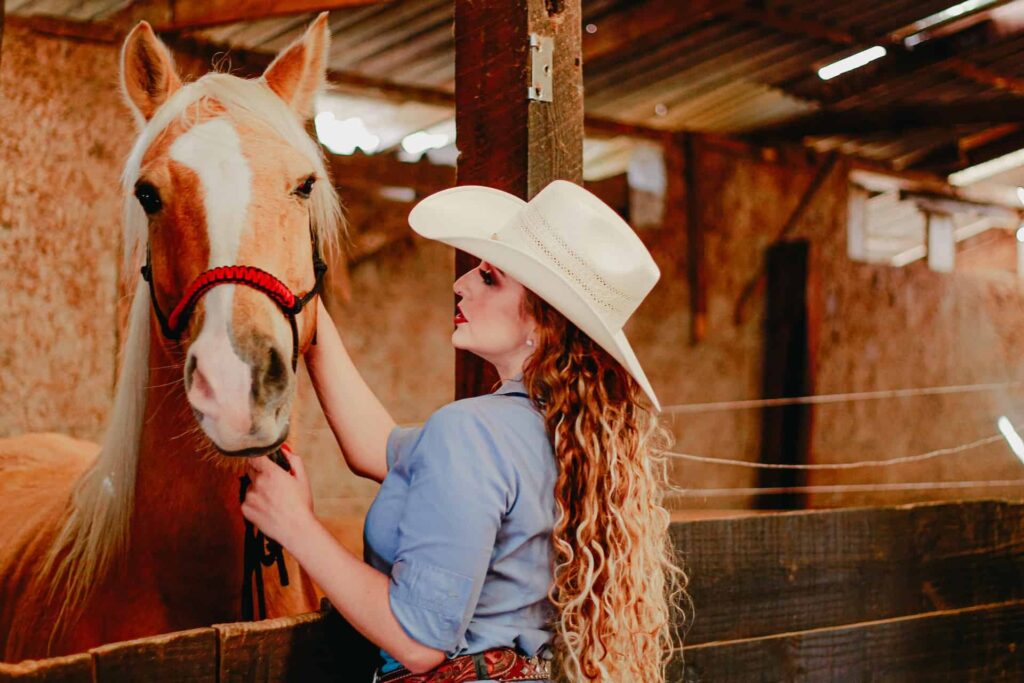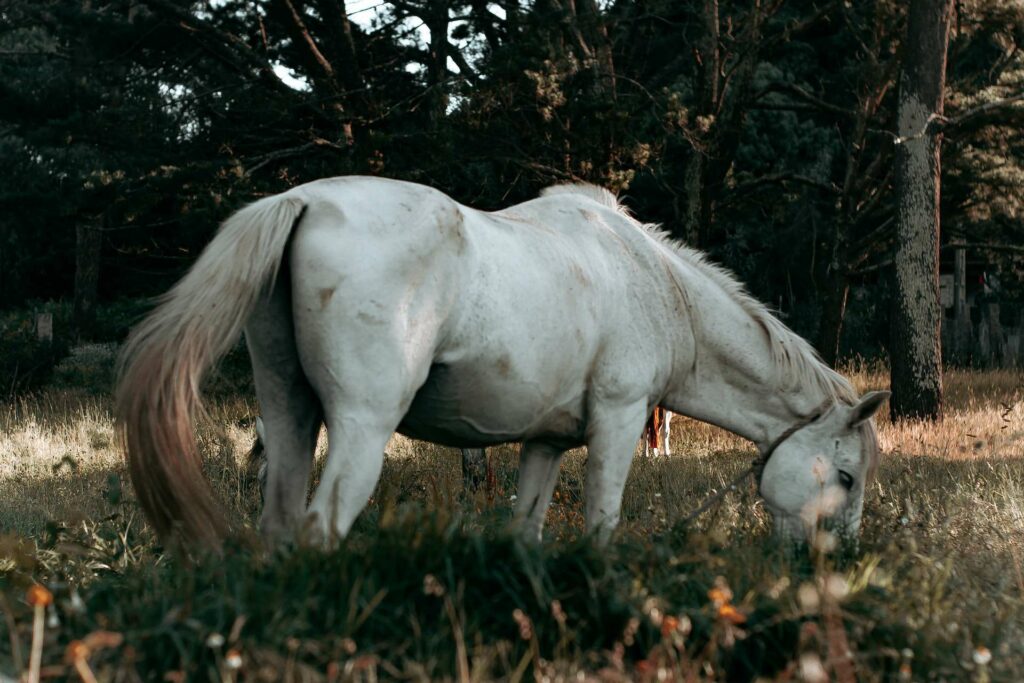Horse turnout refers to the practice of allowing horses to spend time outdoors, unconfined by stalls. This is an essential aspect of equine management, as it contributes significantly to the physical and psychological health of horses. Turnout can range from a few hours to full-time pasture living, depending on the facility’s resources, the horses’ needs, and management decisions.
Providing horses with regular turnout opportunities has been linked to numerous benefits, including reduced stress, improved physical fitness, and increased social interaction among horses. A horse’s behavior and overall well-being are directly impacted by the amount of time it spends in turnout. Equine caretakers are encouraged to tailor turnout routines to suit the individual requirements of each horse, taking into account factors like space availability, herd dynamics, and climatic conditions.
Key Takeaways
- Regular turnout contributes to a horse’s physical and mental health.
- The behavior and well-being of horses are enhanced by suitable turnout practices.
- Turnout routines should be customized to individual horses and environmental factors.
Understanding Horse Turnout
Horse turnout refers to the practice of allowing horses to spend time outdoors, which is essential for their health and well-being. This practice impacts their physical health and mental state, influencing behaviors indicative of positive welfare.
Benefits of Turnout
Turnout offers numerous advantages for a horse’s physical and mental health.
- Physical Health: Regular turnout helps maintain healthy body condition, as it allows horses to move freely, promoting circulation, muscle tone, and digestive health. Horses with adequate turnout time are less likely to exhibit weight management issues, which is a step toward preventing health complications related to obesity.
- Mental Health: Being in a more natural environment, horses can exhibit natural behaviors such as grazing and socializing with other horses, which is crucial for mental stimulation and stress reduction.
Research underscores the importance of providing turnout on pasture, suggesting that horses may not receive sufficient turnout time, which can impact their welfare.
Turnout Practices
Effective turnout practices are tailored to individual horses and consider several factors:
- Duration and Frequency: Horses benefit from daily turnout, ideally with continuous access or for the majority of the day.
- Environment: The area for turnout should be safe and secure, with suitable fencing and free from hazards. Conditions of the pasture impact the quality of turnout, with ample space necessary for free movement.
Behavioral observations and heart rate readings serve as tools for understanding horse responses to different turnout conditions, such as confinement vs. outdoor arenas. These metrics can guide owners in optimizing turnout practices to enhance equine well-being.
Turnout is a critical component of equine care, contributing to the overall health and behavior of horses. Adopting suitable turnout practices is a key aspect of responsible horse ownership and equine welfare.
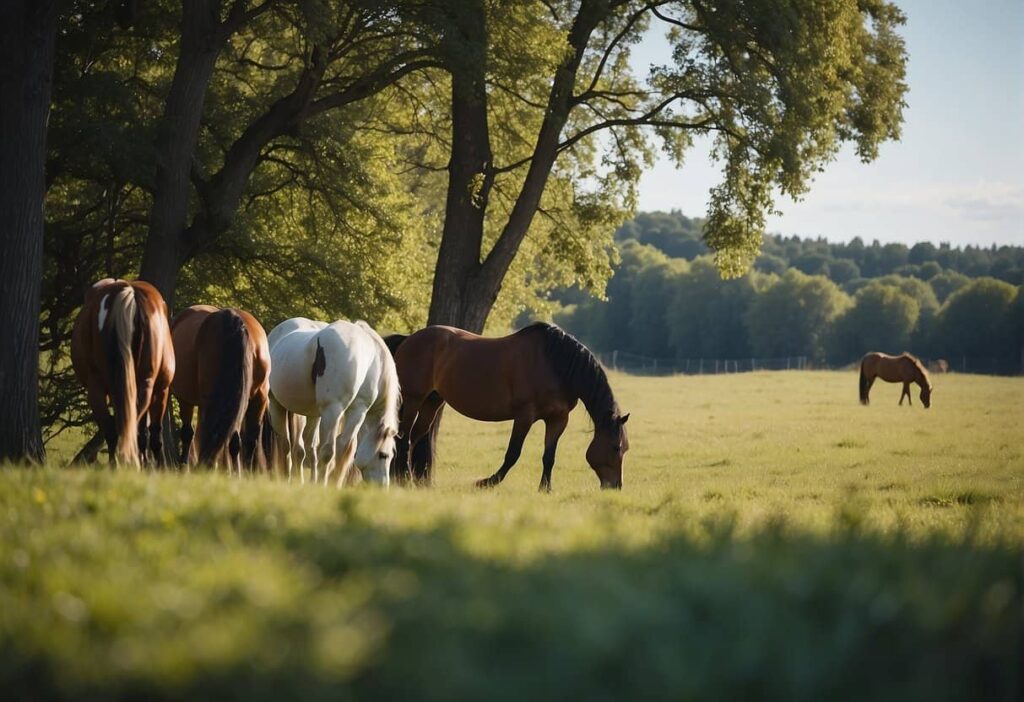
Turnout Environments
Turnout environments greatly influence a horse’s welfare and behavior. Providing suitable pastures and paddocks can significantly enhance their physical health and mental well-being.
Pasture Management
A well-managed pasture offers a safe and natural environment for horses. To sustain pasture quality, rotational grazing should be implemented. This involves dividing a field into smaller sections and allowing only a portion to be grazed at any one time, which supports pasture regrowth and limits overgrazing.
Regular removal of manure can prevent the spread of parasites and encourage uniform grass growth. Adequate fencing, free from sharp protrusions, ensures safety and prevents escape.
Paddock Provisions
For horses without access to large pastures, paddocks serve as smaller outdoor enclosures designed to allow free movement and social interaction. Paddock surfaces should be carefully chosen to prevent injury — soft, non-slip footing is ideal for maintaining paddock integrity and horse comfort.
Shelter, whether natural or constructed, is vital for protection against elements, and regular maintenance ensures a clean and hazard-free outdoor space. Water sources need to be clean, and ice-free, and troughs should be checked daily.
Equine Health and Wellbeing
Proper management of horse turnout is critical for maintaining equine health and well-being, specifically focusing on diet and nutrition, physical health, and mental and emotional health. These components are interconnected and contribute to the overall well-being of a horse.
Diet and Nutrition
For horses, nutrition is foundational to health. The diet must satisfy their needs for energy, vitamins, and minerals to prevent digestive health issues. Overfeeding can lead to obesity and associated health issues, such as laminitis, whereas underfeeding can result in poor body condition and a weakened immune system. Owners should provide a balanced diet that includes:
- High-quality forage to support gut health
- Concentrates, as needed, tailored to the horse’s workload
- Access to clean water at all times
Physical Health
The physical health of horses is multifaceted, encompassing hoof health, respiratory health, and musculoskeletal health. Regular turnout on varied terrain can improve blood circulation in the hooves, reducing the risk of conditions like thrush or white line disease. Exposure to fresh air is beneficial for respiratory health, helping to prevent chronic inflammatory airway disease. Additionally, space to move freely is essential for maintaining healthy joints and muscles, reducing the risk of musculoskeletal issues.
Mental and Emotional Health
Mental and emotional health are as important as physical health for equines. Horses are herd animals by nature, and turnout provides them with the opportunity to socialize, which is crucial for their mental well-being. It allows them to exhibit natural behaviors, which can reduce stress and prevent behavior problems. An environment that mimics a horse’s natural habitat contributes positively to their overall well-being.
Behavioral Considerations
When considering turnout for horses, it’s important to acknowledge the impact it has on their natural behaviors and the management of potential behavioral issues. Turnout not only facilitates the expression of innate behaviors but also plays a crucial role in mitigating stress-related vices.
Natural Behaviors
Horses exhibit a range of natural behaviors that are essential for their psychological and physical well-being. They are instinctively social animals, which means they thrive on social interaction and the opportunity to socialize with other horses. Activities such as play and mutual grooming are common in a herd and contribute significantly to a horse’s mental health. In terms of movement, horses naturally roam and forage for many hours, which is critical for gut motility and reducing the risk of colic. Restricted movement, often seen in stalled horses without adequate turnout, can lead to a decrease in motility and an increased risk of digestive distress.
Behavior Management
Proper turnout can be a key element in the management and prevention of unwanted behaviors, known as stereotypic behaviors or vices. Cribbing, where a horse grasps an object with its teeth and inhales air, can be a behavioral issue stemming from boredom or anxiety. Regular turnout allows horses to engage in natural grazing behaviors, countering the tendency towards cribbing.
Weaving, a repetitive side-to-side swaying, is often a sign of stress that can be alleviated through turnout, as it allows horses to move freely and dissipate tension. By prioritizing turnout, horse caretakers help mitigate numerous vices by offering an outlet for pent-up energy and boredom, thus promoting healthier behavior patterns and reducing overall stress and anxiety in the animal.
Incorporating turnout into a horse’s routine is not just a matter of preference but a necessity for maintaining their natural behaviors and managing behavioral issues effectively.

Facilities and Equipment
Proper facilities and equipment are vital for the health and well-being of horses during turnout. They should include secure stabling, reliable fencing, and adequate shelter and water access. It is essential to consider the specific needs of the horses when designing and equipping these spaces.
Stabling Requirements
Stalls: Stables should provide spacious stalls with dimensions appropriate for the size and number of horses. They need to be well-ventilated and have sufficient lighting. Stalls must also include adequate bedding to support equine health and comfort.
| Horse Size | Stall Width | Stall Length |
|---|---|---|
| Small | 10 feet | 10 feet |
| Medium | 12 feet | 12 feet |
| Large | 14 feet | 14 feet |
Stable: A well-designed stable will also include areas for feed and equipment storage, which must be rodent-proof and easily accessible.
Fencing and Security
Fencing: Turnout areas require durable fencing that prevents escape and protects horses from injury. Electric fencing is commonly used due to its flexibility and effectiveness.
Bulleted list of fencing features:
- Height appropriate for the horse breed and size.
- Visibility to prevent accidental collisions.
- Maintenance checks to ensure ongoing integrity and safety.
Security: Safety precautions include locks on gates and regular checks of the fencing perimeter to prevent unauthorized access and ensure the continued confinement and safety of the horses.
Shelter and Water Access
Outdoor Shelter: Horses with full-time turnout may require an outdoor shelter to protect them from the elements. Shelters should be well-constructed, free of sharp edges, and large enough for the number of horses using the turnout.
Clean Water: Horses must have access to clean water at all times. Water troughs should be regularly cleaned to prevent algae growth and the spread of disease.
List of water access considerations:
- Placement of water sources away from areas where horses are likely to defecate.
- Use of heated water troughs in colder climates to prevent freezing.
Grazing Muzzle: For horses with dietary restrictions, a grazing muzzle might be necessary. It allows horses to enjoy turnout without overgrazing or exacerbating health issues.
By ensuring that these facilities and equipment standards are met, those who manage stables can offer a secure and nurturing environment for horses during turnout periods.
Management Practices
Effective horse management strategies are pivotal in ensuring equine welfare and optimizing their overall well-being. This focus on daily care practices contributes to the physical and mental health of horses, influencing their ability to meet work requirements and maintain fitness levels.
Group Dynamics
Involving horses in group turnout is a common practice that supports their instinctual need for companionship. Studies have shown that horses often benefit from social interactions, aiding in reducing behaviors like stall walking. However, careful management is required to balance the group dynamics to prevent aggression and to cater to each horse’s nutrition and hydration needs. Group composition is routinely adjusted according to compatibility and horsemanship to maximize the benefits of social grazing on pasture.
Exercise and Activity Levels
Paddock turnout serves as a key factor in maintaining a horse’s fitness levels, providing them an environment for natural exercise. It also satisfies their behavioral need for grazing, which can help regulate calorie intake. Regular turnout practices encourage movement and are crucial for horses that are subjected to intense work requirements. Sufficient activity aids in preventing issues related to confinement such as limb swelling and digestive problems.
Safety and Health Monitoring
Ongoing safety and health monitoring is an integral part of horse care during turnout. This includes regular checks for injuries and ensuring that the Henneke body condition scale is utilized to monitor their condition and adjust feed accordingly. Turnout areas should be evaluated for hazards, and the horse care protocol must include strategies for extreme weather. Finally, close attention to equine behavior during turnout can provide early indicators of health issues, allowing for timely intervention.
Seasonal Considerations
When managing horse turnout, understanding how seasonal changes affect equine well-being is essential. It includes being mindful of varying weather conditions, ensuring proper shelter, and recognizing the impact of environmental factors such as dust and allergens.
Weather Impact on Turnout
Changes in weather conditions with the seasons can greatly influence equine health and behavior. Summer heat necessitates access to shade and clean water to prevent dehydration and heat stress. In contrast, winter may require additional shelter and warmth as horses can be susceptible to pneumonia if left damp and chilled.
Care should be taken to minimize exposure to dust in dry climates, which can contribute to recurrent airway obstruction (RAO), and ammonia fumes from wet, unclean bedding. These issues are heightened in certain weather conditions and can lead to respiratory problems.
Owners should be proactive in monitoring for signs of weather-related stress, including changes in respiratory rate or signs of discomfort.
Adapting to Climate
Adapting turnout areas to suit the climate involves offering varied terrain to encourage exercise and stimulation. For hot and sunny climates, providing ample shade can protect horses from sunburn and overheating. Cooler climates may call for windbreakers or shelters to provide refuge from cold winds and rainfall.
In all climates, horses should have room to move — this not only aids in circulation but also in maintaining healthy insulin levels, combating issues like insulin resistance.
Keeping paddocks clean and dry reduces the risk of environmental hazards such as allergens and pathogens, further safeguarding horse health year-round.
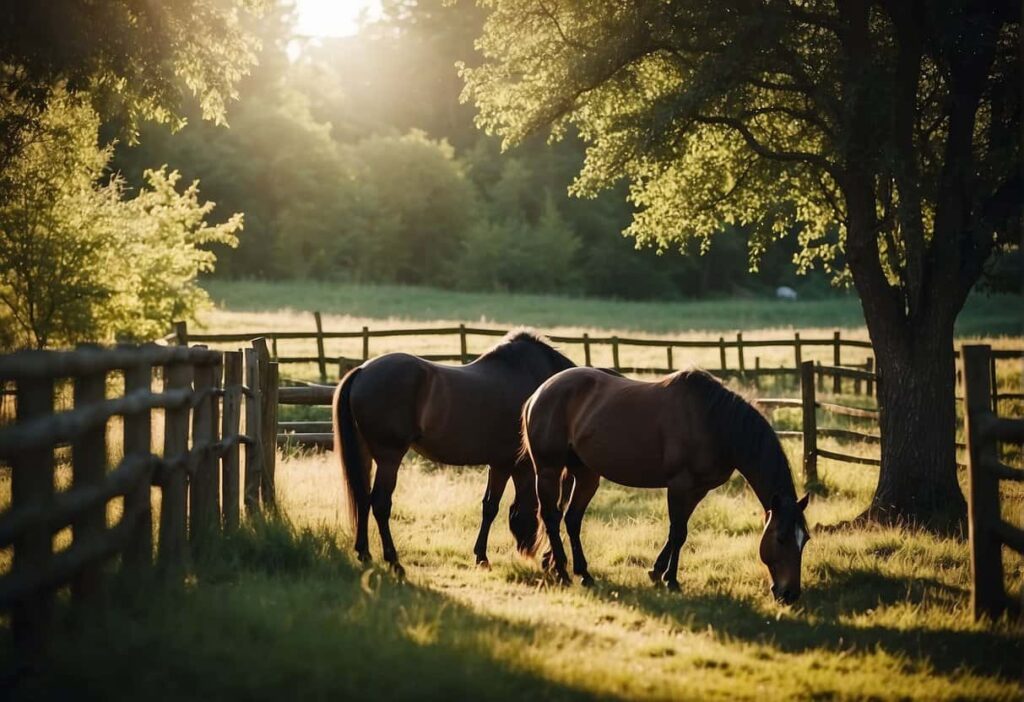
Special Considerations
When managing horse turnout, each horse’s well-being is paramount. Consideration of their physical and psychological needs is essential to ensure their health and happiness.
Health Challenges
Stress and confinement can lead to a myriad of health challenges in horses. For instance, restricted movement may result in joint stiffness or digestive issues, as regular exercise is critical for maintaining joint mobility and a healthy digestive system. Ensuring ample space for movement can mitigate these issues. Additionally, horses showing signs of pawing or other stress behaviors may need changes to their turnout routine to alleviate anxiety.
Environments that are too confining can contribute to Recurrent Airway Obstruction (RAO), also known as heaves, a condition analogous to asthma in humans. Owners should ensure that horses at risk of or suffering from RAO have access to well-ventilated areas and are not confined to dusty or moldy stables.
Specific Needs for Different Horses
Different horses have varying turnout needs. Socialization is critical for a horse’s happiness; thus, solitary confinement can be detrimental. When possible, a horse should be allowed to interact with several horses to emulate their natural social structures. However, care must be taken to introduce horses to new social groups gradually to minimize aggression and injury.
Potential hazards in turnout areas, such as sharp objects or poisonous plants, must be identified and removed to safeguard the horses. Fields must be inspected for these risks regularly.
Equine care also includes providing consistent access to fresh water to prevent dehydration and colic. Water sources should be clean and unfrozen, and it is the responsibility of the caregiver to check and refill water troughs daily.
Each horse is an individual with unique needs, and one must consider these special considerations carefully to promote their welfare.
Frequently Asked Questions
The following faqs shed light on crucial aspects of turnout for horses, delving into the benefits and necessary considerations for their well-being and comfort in various weather conditions.
What are the advantages of using horse turnout blankets during colder seasons?
Horse turnout blankets provide warmth and protection for horses during colder seasons, helping to maintain a healthy body temperature and guard against weather-induced stress.
How can summer turnout sheets benefit horses in warmer weather?
Summer turnout sheets are designed to shield horses from harmful UV rays and biting insects, while also preventing overheating due to their lightweight and breathable fabric.
What are the key benefits of regular turnout for equine health?
Regular turnout for horses is essential for promoting physical exercise, reducing stress, and encouraging natural foraging behaviors, which together contribute to overall better physical and mental health.
What considerations should be made for maintaining an all-weather horse turnout paddock?
An all-weather turnout paddock should have adequate drainage to prevent mud buildup, shelter for weather protection, and sturdy fencing to ensure the safety and comfort of the horses in various environmental conditions.
Could feeding horses alfalfa lead to swelling in their legs, and how can this be prevented?
Feeding horses alfalfa could lead to leg swelling if consumed in large quantities due to its higher protein content. To prevent such incidents, it’s crucial to balance the diet with lower protein forages and ensure adequate exercise.
What are the implications of limited or no turnout on a horse’s wellbeing?
Limited or no turnout can result in a range of issues for horses, including behavioral problems, lack of socialization, and an increased risk of health conditions such as obesity and colic. It is important to provide horses with sufficient turnout time to promote their overall well-being.
Last Updated on January 4, 2024 by Nate Dewsbury
